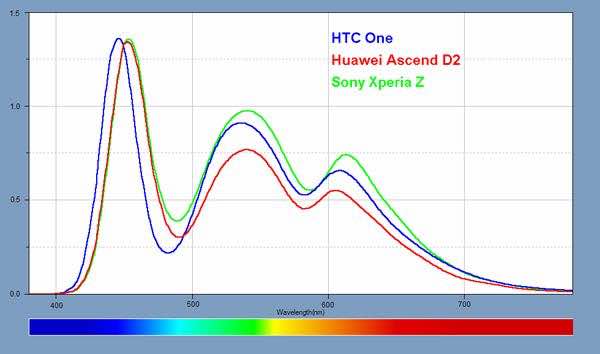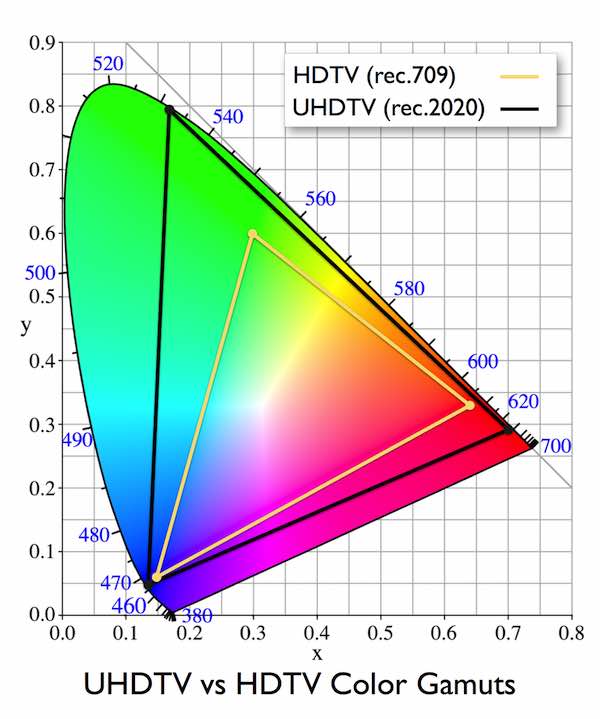In a recent press release Corning and Healthe announced their collaboration on protecting eyes against damage from digital device blue light exposure. This collaboration is based on Healthe offering Eysafe covers for smartphones, tablets, monitors, and laptop displays. The covers are based on Corning’s Accessory 2 glass and introduce not only protection from UV light but also a PRF (Retina Protection Factor) for the user. In case you wonder what you need a PRF for, I suggest a deep dive into several medical research papers that suggest that not only UV light but also high energy blue light (anything below 465 nm) is potentially damaging to the eye.
Electromagnetic spectrum as seen by Eysafe / Healthe
There are several aspects that may make HEV (high energy visible) blue light dangerous. Here is a short rundown on those factors.
- Eyes from children and teenagers below the age of 18 are more susceptible to blue light as their eyes are still very clear and allow the blue light to penetrate deeper into the eye. As we age a yellowing of lens absorbs more of the blue light and thus provide better protection.
- HEV blue light can damage the retina and cause vision issues later in life.
- With the appearance of the smartphone and tablet our screen time especially for children has dramatically increased, compounding the risks mentioned above.
- The naturally occurring HEV blue light in daylight controls our melatonin production and with that our sleep cycle. In other words using smartphones and tablets for reading in bed messes with our natural sleep cycle.
- Electronic displays reduce the blinking rate of our eyes, leading to dry and sore eyes. This contributes to eyestrain for all age groups.
- Some research suggests that damage from HEV blue light to the retina maybe cumulative raising more of a long term concern as well.
When visiting the website of Healthe, one can find several references for each of these topics. It appears this is by no means a small issue for the display industry.
Analyst Comment
Reading the above articles as shown by Healthe / Eyesafe, one has to wonder if we are missing an important part of the display technology development in creating potentially unsafe displays for the user. This is where it is getting a little tricky to understand the potential danger and the consequences for the display industry. Once these dangers are documented and widely published long term exposure to such displays and the consequential vision damage may lead to long lasting law suits, at least in US courtrooms. If you think that I am dreaming, just think about the law suits about smoking.
If these effects create real danger for the vision of consumers we should at least discuss what could be done to avoid such a situation. The first question that comes to mind is if we are potentially increase this risk by moving towards a wide color gamut display. We discuss this topic often and as technology writers we tend to react positively to any company that can push the possible color gamut with a new and improved display technology. So let us take a look at the actual display situation in regards to HEV blue light.
First of all is there any? According to measurements published by Ray Soneira from Display Mate, there is indeed a good amount of blue light below 465 nm coming smartphone display as is shown in the graph below.
 Smartphone spectra as measured by Display Mate
Smartphone spectra as measured by Display Mate
As a matter of fact it seems that for the HTC One most of the blue light falls in the range below 465nm. This seems to be true for most LCD displays, while the AMOLED displays are shifted more to the longer wavelength. The spectrum is on a linear scale and blue light with a wavelength of 425nm has a significant intensity.
If the existing devices do emit HEV blue light in considerable amounts how does this correlate with the respective color gamuts? From an theoretical standpoint the color gamuts fall within the visible spectrum and do reach out very little into the HEV blue light regime. This can be seen in the following color gamut chart.
 Color gamut of rec2020 vs rec709 001
Color gamut of rec2020 vs rec709 001
There seems to be very little or no overlap of the color gamut with the Rec 709 and Rec 2020 standards.The violet blue segment of the visible light is not part of the standard. This means that the actual presence of light below 465nm is a question of technology implementation and not the extended color gamut. So far for the good news. The bad news is that more or less all mobile devices do emit HEV blue light and potentially endanger the users.
How does Healthe / Eyesafe address this issue? The Accessory glass 2 from Corning is basically a chemically strengthened glass with high transmissivity down to 380nm. It provides scratch and drop resistance to the cover glass. Healthe adds organic dyes to the surface to absorb the HEV blue light. Of course, adding an edge filter to the front of a display changes the white point and all the color reproduction. To preserve the color performance of the display, they seem to add a neutral density filter for the green and red light to balance out the loss of the HEV blue light. This comes of course at a price, mainly the display brightness / power consumption. In addition a lot of the color reproduction has to do with the software playing in sync wth the display and the respective color primaries. Changing those may also affect the overall color balance, as the software does not know about the change of the emitted light spectrum. Implementing this solution into the display itself maybe preferable.
This leaves us with the question on how real this danger is. I assume that more research is underway to prove or disprove the underlying issues of HEV blue light. So far it seems that there is something going on in our vision system that we so far have not considered in display technology development. Interestingly, the makers of reflective ePaper displays always were looking for any prove of eye strain resulting from using light emitting displays. Maybe here we have the scientific reasoning e-paper makers have looked for so long. (NH)
By coincidence, I was at the LG OLED event in Munich (covered in LDM as there was almost nothing outside TV discussed) and at that event, Dr James Sheedy, of the Pacific University, Oregon, said that while he believes that there is an effect from blue light on sleep patterns, the levels of blue light needed to cause real damage were not seen outside the laboratory and were not an issue for electronic displays. We have published nearly fourty articles tagged ‘blue light’ over the last couple of years, so there are lots of links if you want to dig into this topic.
I wrote a Display Daily on this topic last year (Are LED Backlights Dangerous?) which has some more background. At the time, TÜV was certifying products. Since then, I have asked the organisation multiple times what they are testing and to what level, as there seemed to be nothing on the website, but have not had any responses beyond ‘We got your mail’. Pah! (BR)
(BR)

